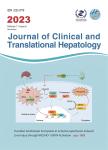Nontumoral Portal Vein Thrombosis:A Challenging Consequence of Liver Cirrhosis
作者机构:Division of GastroenterologyDepartment of MedicineFaculty of MedicineSiriraj HospitalMahidol UniversityBangkokThailand
出 版 物:《Journal of Clinical and Translational Hepatology》 (临床与转化肝病杂志(英文版))
年 卷 期:2020年第8卷第4期
页 面:432-444页
核心收录:
学科分类:1002[医学-临床医学] 100201[医学-内科学(含:心血管病、血液病、呼吸系病、消化系病、内分泌与代谢病、肾病、风湿病、传染病)] 10[医学]
主 题:Portal vein thrombosis Liver cirrhosis Clinical course Anticoagulation Transjugular intrahepatic portosystemic shunt
摘 要:Nontumoral portal vein thrombosis (PVT) is an increasingly recognized complication in patients with cirrhosis. Substantial evidence shows that portal flow stasis, complex thrombophilic disorders, and exogenous factors leading to endothelial dys-function have emerged as key factors in the pathogenesis of PVT. The contribution of PVT to hepatic decompensation and mortality in cirrhosis is debatable;however, the presence of an advanced PVT increases operative complexity and decreases survival after transplantation. The therapeutic decision for PVT is often determined by the duration and extent of thrombosis, the presence of symptoms, and liver transplant eligibility. Evidence from several cohorts has demonstrated that anti-coagulation treatment with vitamin K antagonist or low mo-lecular weight heparin can achieve recanalization of the portal vein, which is associated with a reduction in portal hyper-tension-related events and improved survival in cirrhotic patients with PVT. Consequently, interest in direct oral anti-coagulants for PVT is increasing, but clinical data in cirrhosis are limited. Although the most feared consequence of anti-coagulation is bleeding, most studies indicate that anticoagu-lation therapy for PVT in cirrhosis appears relatively safe. Interestingly, the data showed that transjugular intrahepatic portosystemic shunt represents an effective adjunctive ther-apy for PVT in cirrhotic patients with symptomatic portal hypertension if anticoagulation is ineffective. Insufficient evi-dence regarding the optimal timing, modality, and duration of therapy makes nontumoral PVT a challenging consequence of cirrhosis. In this review, we summarize the current literature and provide a potential algorithm for the management of PVT in patients with cirrhosis.



